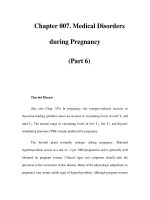Chapter 007. Medical Disorders during Pregnancy (Part 1) pot
Bạn đang xem bản rút gọn của tài liệu. Xem và tải ngay bản đầy đủ của tài liệu tại đây (12.87 KB, 5 trang )
Chapter 007. Medical Disorders
during Pregnancy
(Part 1)
Harrison's Internal Medicine > Part 1. Introduction to Clinical
Medicine > Chapter 7. Medical Disorders during Pregnancy
Medical Disorders during Pregnancy: Introduction
Approximately 4 million births occur in the United States each year. A
significant proportion of these are complicated by one or more medical disorders.
Three decades ago, many medical disorders were contraindications to pregnancy.
Advances in obstetrics, neonatology, obstetric anesthesiology, and
medicine have increased the expectation that pregnancy will result in an excellent
outcome for both mother and fetus despite most of these conditions.
Successful pregnancy requires important physiologic adaptations, such as a
marked increase in cardiac output. Medical problems that interfere with the
physiologic adaptations of pregnancy increase the risk for poor pregnancy
outcome; conversely, in some instances pregnancy may adversely impact an
underlying medical disorder.
Hypertension
(See also Chap. 241)
In pregnancy, cardiac output increases by 40%, most of which is due to an
increase in stroke volume. Heart rate increases by ~10 beats/min during the third
trimester.
In the second trimester of pregnancy, systemic vascular resistance
decreases and this is associated with a fall in blood pressure. During pregnancy, a
blood pressure of 140/90 mmHg is considered to be abnormally elevated and is
associated with an increase in perinatal morbidity and mortality.
In all pregnant women, the measurement of blood pressure should be
performed in the sitting position, because for many the lateral recumbent position
is associated with a blood pressure lower than that recorded in the sitting position.
The diagnosis of hypertension requires the measurement of two elevated
blood pressures, at least 6 h apart. Hypertension during pregnancy is usually
caused by preeclampsia, chronic hypertension, gestational hypertension, or renal
disease.
Preeclampsia
Approximately 5–7% of all pregnant women develop preeclampsia , the
new onset of hypertension (blood pressure >140/90 mmHg) and proteinuria (>300
mg/24 h) after 20 weeks of gestation. Although the precise placental factors that
cause preeclampsia are unknown, the end result is vasospasm and endothelial
injury in multiple organs.
Excessive placental secretion of a soluble fms-like tyrosine kinase 1, a
naturally occurring vascular endothelial growth factor antagonist, and decreased
secretion of placental growth factor may contribute to the endothelial dysfunction,
hypertension, and proteinuria observed in preeclampsia.
Glomerular endothelial cells demonstrate swelling and encroach on the
vascular lumen. Preeclampsia is associated with abnormalities of cerebral
circulatory autoregulation, which increase the risk of stroke at near-normal blood
pressures.
Risk factors for the development of preeclampsia include nulliparity,
diabetes mellitus, a history of renal disease or chronic hypertension, a prior history
of preeclampsia, extremes of maternal age (>35 years or <15 years), obesity,
factor V Leiden mutation, angiotensinogen gene T235, G20210A prothrombin
gene mutation, antiphospholipid antibody syndrome, and multiple gestation.
Severe preeclampsia is the presence of new-onset hypertension and
proteinuria accompanied by central nervous system (CNS) dysfunction
(headaches, blurred vision, seizures, coma), marked elevations of blood pressure
(>160/110 mmHg), severe proteinuria (>5 g/24 h), oliguria or renal failure,
pulmonary edema, hepatocellular injury (ALT > 2 x the upper limits of normal),
thrombocytopenia (platelet count < 100,000/L), or disseminated intravascular
coagulation.
Women with mild preeclampsia are those with the diagnosis of new-onset
hypertension, proteinuria, and edema without evidence of severe preeclampsia.
The HELLP (hemolysis, elevated liver enzymes, low platelets) syndrome is
a special subgroup of severe preeclampsia and is a major cause of morbidity and
mortality in this disease. The presence of platelet dysfunction and coagulation
disorders further increases the risk of stroke.









